2023-03-03 オランダ・デルフト工科大学(TUDelft)
3月3日に発表された研究によれば、球状、鞍状、平板状の3つの形状のうち、鞍状の形状が骨細胞の新しい組織形成を促進することが分かった。この研究は、損傷した組織の修復のための研究にとって重要な一歩となる可能性がある。
高精度の3Dプリンティング技術を使用して、細胞が認識できるほど小さい形状を作成し、最適な生体材料とインプラントの形状についてのガイドラインを提供する。
この研究は、組織再生を最大化するために必要な複雑な幾何学的設計を示しており、安価であるため、薬剤よりも優れているとしている。
- https://www.tudelft.nl/en/2023/tu-delft/new-tool-for-organ-repair-curvature-of-the-environment
- https://www.nature.com/articles/s41467-023-36436-w
複雑な曲率場における骨細胞の創発的な集団組織化 Emergent collective organization of bone cells in complex curvature fields
Sebastien J. P. Callens,Daniel Fan,Ingmar A. J. van Hengel,Michelle Minneboo,Pedro J. Díaz-Payno,Molly M. Stevens,Lidy E. Fratila-Apachitei & Amir A. Zadpoor
Nature Communications Published:03 March 2023
DOI:https://doi.org/10.1038/s41467-023-36436-w

Abstract
Individual cells and multicellular systems respond to cell-scale curvatures in their environments, guiding migration, orientation, and tissue formation. However, it remains largely unclear how cells collectively explore and pattern complex landscapes with curvature gradients across the Euclidean and non-Euclidean spectra. Here, we show that mathematically designed substrates with controlled curvature variations induce multicellular spatiotemporal organization of preosteoblasts. We quantify curvature-induced patterning and find that cells generally prefer regions with at least one negative principal curvature. However, we also show that the developing tissue can eventually cover unfavorably curved territories, can bridge large portions of the substrates, and is often characterized by collectively aligned stress fibers. We demonstrate that this is partly regulated by cellular contractility and extracellular matrix development, underscoring the mechanical nature of curvature guidance. Our findings offer a geometric perspective on cell-environment interactions that could be harnessed in tissue engineering and regenerative medicine applications.


